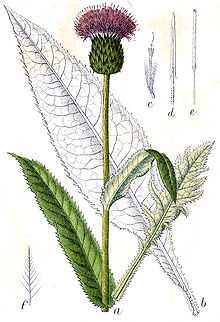Cirsium heterophyllum
| Cirsium heterophyllum | |
|---|---|
 | |
| Cirsium heterphyllum (Melancholy Thistle) | |
| Scientific classification | |
| Kingdom: | Plantae |
| (unranked): | Angiosperms |
| (unranked): | Eudicots |
| (unranked): | Asterids |
| Order: | Asterales |
| Family: | Asteraceae |
| Subfamily: | Carduoideae |
| Tribe: | Cynareae |
| Genus: | Cirsium |
| Species: | C. heterophyllum |
Cirsium heterophyllum, also known as Melancholy Thistle, is an erect spineless herb. It is found in England, Wales and Scotland but not in the south of these countries. In Ireland it is very rare, and Denmark it is only locally found. It grows in upland meadows, grasslands, roads and open woods.
Description

It is a perennial herb. Unusually for a thistle, it lacks spines. The plant grows 45 to 120cm tall, and forms runners. The stem is grooved, more-or-less branchless, and cottony. The leaves are green and hairless above, thick white felted underneath. The base leaves are lanceolate with stalks and softly prickly edges, and grow from 20 to 40 cm long, and from 4 to 8 cm wide. The upper leaves do not have stalks, clasping the stem with cordate (heart-shaped) bases. The flower heads are 3 to 5 cm long and wide, red-purple in colour, and appear from July to August.[1]
Similar species
Cirsium dissectum (Meadow Thistle) is a more slender version.
Medical use
The plant was considered a possible cure for sadness. Nicholas Culpepper in 1669 said that it "makes a man as merry as a cricket".[2]
References
- ↑ Rose, Francis (1981). The Wild Flower Key. Frederick Warne & Co. pp. 382–383. ISBN 0-7232-2419-6.
- ↑ www.ukwildflowers.com